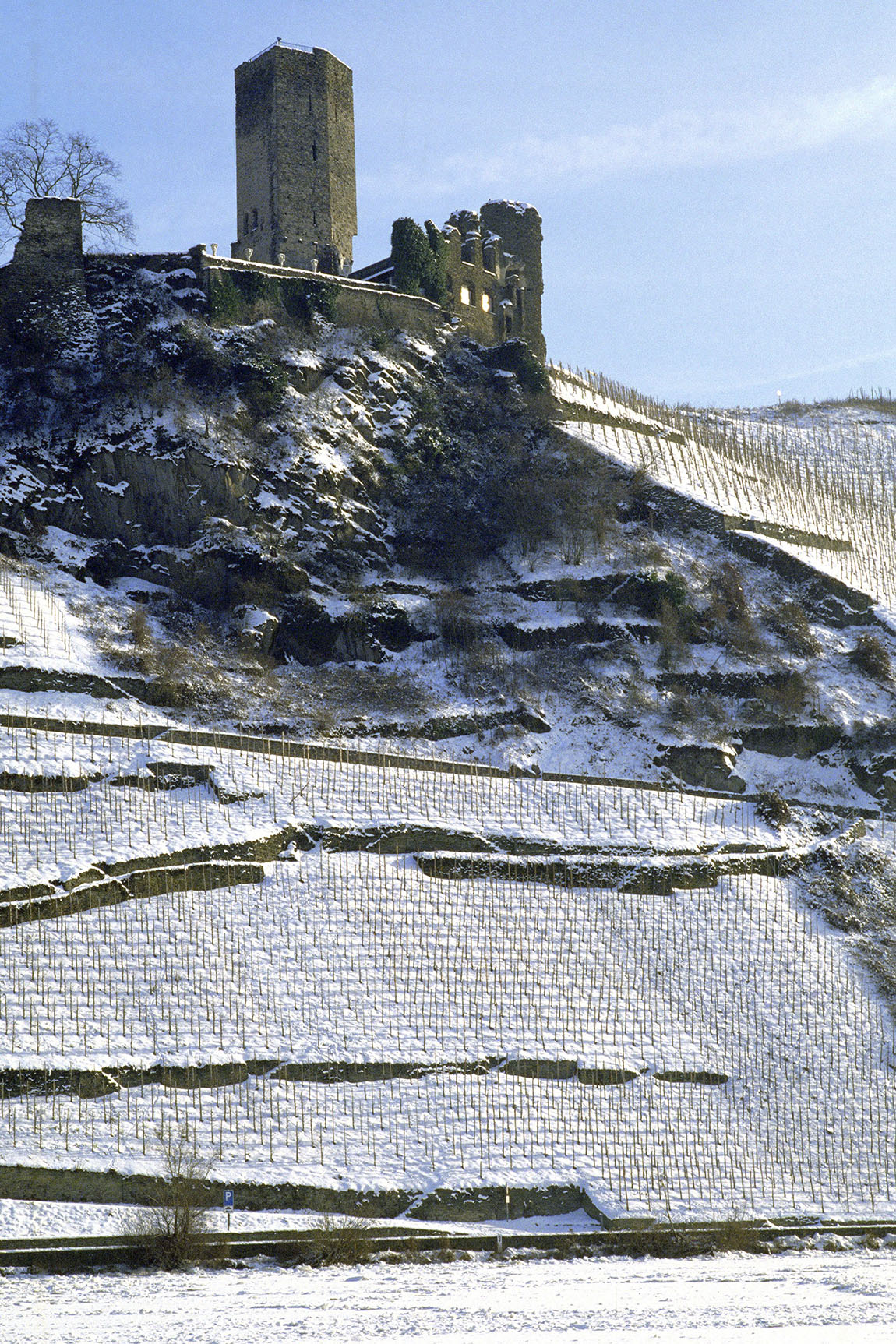The Wine from the Cold
TEXT: WIBKE CARTER

Spitzhaus Radebeulin winter. Photo: Florian Kneffel
Ice wine – a true rarity. Mother Nature and Father Frost rarely offer winemakers this unique opportunity. Full of risks, but all the more exciting. Because when the ice wine succeeds, winemakers and wine connoisseurs are equally delighted.
The story of Eiswein, one of the most appreciated German sweet wines, begins in the early 19th century in Bingen-Dromersheim near the Rhine River. 1829 was a rather bad wine year, and many grapes were not harvested due to poor quality. When, in the middle of winter and after heavy frosts, the winegrowers picked the grapes left on the vines in order to feed them to the cattle, they discovered that they had little juice, but a wonderful sweetness with a high must weight. From the grapes squeezed, the first ice wine was made in February 1830.
For a long time, Germany and Austria were the only countries where ice wine was produced. In 1975, however, Canada also began production and since then has even become the world’s largest producer. The special, more expensive wine (produced in much smaller quantities than many other wines) is made mainly from Vidal Blanc, Chenin Blanc and Riesling.

Sparkling wine production. Photo: www.deutscheweine.de
It’s a risky business
When winemakers play poker, the stakes are high. The grapes hang on the vines longer than usual, waiting for temperatures of at least -7°C, ideally -10 to -12°C, for several hours. The winemaker’s all-or-nothing-game with Mother Nature can last until January, and in rare cases, February, and involves the risk of total loss.
If it does not get cold enough, no ice wine is harvested. On average, only about 5-10% of the original harvest is bottled as ice wine. The remaining portion of grapes is selectively cut out or falls victim to the unpredictable weather conditions. In 2019/20, due to the mild winter, only four German wineries were able to harvest ice wine on 5 December, 2019 and 22 January, 2020.
The actual harvest, which usually takes place in the early morning hours, is exhausting. The cold makes the fingers stiff and sensitive to pain. The frozen grapes are laboriously harvested, and in the end, the yield is often only between 300 and 500 litres per hectare. Nevertheless, the production of an ice wine is a challenge that a winery is happy to take on. After all, this speciality is always a masterpiece of the winemaker, which can only be produced in northern wine regions. The wine, which is produced as a rarity from the very beginning, demands high prices, nevertheless, the few bottles are always in great demand.

Wine harvest with use of special ice. Photo: www.deutscheweine.de
Putting in the hours
When making ice wine, quality takes precedence over quantity. This requires some preparation and a special commitment on the part of the winemaker, because ice wine is not a product of chance. Strict and rigorous quality management in the vineyard and special cultivation measures throughout the growing season such as yield-reducing pruning in the spring and strict selection of the grapes before the actual harvest are a prerequisite for a good ice wine. Once the grapes are fully ripe, the ice wine plots are partially defoliated and wrapped in foil to protect them from bird predation.

Vineyards along the Mosel, Beilstein Photo: www.deutscheweine.de
The secret of ice wines lies in the dense concentration of the grape ingredients and a comparatively high acidity – a phenomenon achieved by freezing the berries on the vine. The overripe, naturally frozen grapes are picked and pressed while frozen. The water contained in the grapes thus remains as ice on the winepress, while only the sweetest juice, whose freezing point is lower than that of water, is obtained as a highly concentrated must.
Musts with such high sugar contents can only be fermented into wine by yeast with great difficulty. Accordingly, German ice wines usually have very high natural residual sugar contents of well over 100 grams per litre, but in contrast to southern sweet wines they have relatively low alcohol content – often only about 7% by volume.

Photo: www.deutscheweine.de
Pairings
Healthy grapes (without botrytis infestation, which is responsible for the so-called noble rot) guarantee a fresh and concentrated fruity taste, and the wines usually have a relatively stable acidity. Ice wines are therefore very drinkable even at a young age.
They are an excellent aperitif which makes gourmets go into raptures, and also promise a sweet finale paired with fruity desserts, ice cream or sorbets.
An interesting composition results when combined with ripe blue cheese: On the one hand, the salty to slightly bitter notes of the creamy cheese, on the other hand, the fruity sweet aromas of the concentrated wine which smoothly coats the palate and tongue, add up to an extraordinary taste experience.

East Side Gallery. Photo: www.deutscheweine.de
Subscribe to Our Newsletter
Receive our monthly newsletter by email




